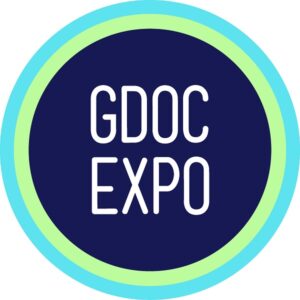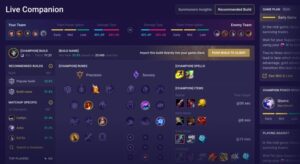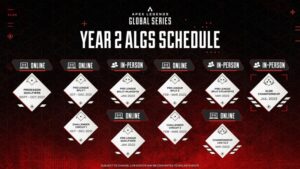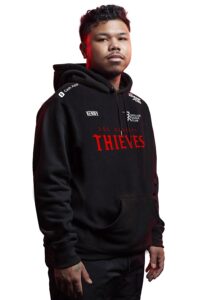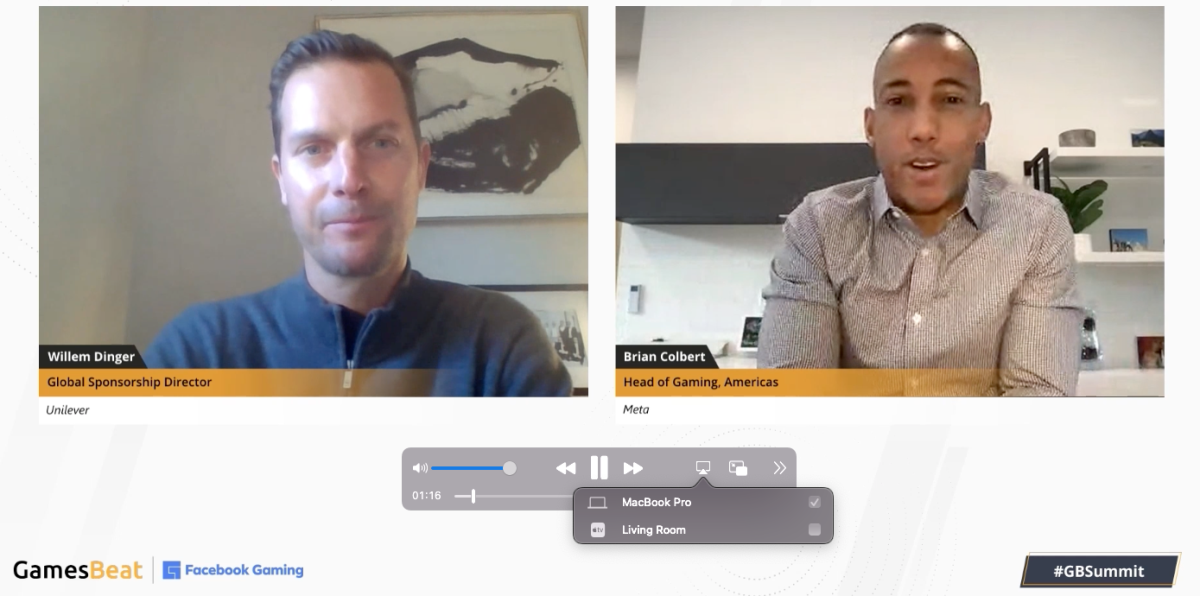
Did you miss a session from the Future of Work Summit? Head over to our Future of Work Summit on-demand library to stream.
There are more than 2.7 billion gamers worldwide, and the market will surpass $200 billion by 2023. Unilever, the global company with some truly iconic brands, is gunning for it. Last year, Hellmann’s and Animal Crossing: New Horizons joined forces for a charity event; Venus, the women’s razor brand, also spent some time with Animal Crossing, creating realistic, inclusive skins for player characters, a campaign that measured nearly 1 billion impressions. Across the pond, Axe sponsored some top gamers, and in China, they’re sponsoring wildly popular e-sport celebrities and leagues — and there’s more.
Willem Dinger, global sponsorship director for Unilever, joined Brian Colbert, head of gaming Americas for Meta, at the 2nd Annual GamesBeat & Facebook Gaming Summit to talk about what they’ve learned from their foray into the gaming space, and why brand building is so important for gaming companies.
Gaming is critical for their brands’ marketing strategies, Dinger said. It’s so mission critical that they created their UPLAY division, which is an expertise division within their media team to help demystify the gaming ecosystem for their brand portfolio, offering them outside inspiration in terms of master classes, broadcasters, streamers, creators, influencers.
“We’re helping them co-create briefs, and also helping them with their implementation and activation strategies,” he said. “You would have seen the amazing activation we did with Hellmann’s and Animal Crossing. That was purpose-driven. It was about turning virtual food waste into real food for real people.”
Webinar
Three top investment pros open up about what it takes to get your video game funded.
And purpose is the cornerstone for all of Unilever’s brands, Dinger said. Their brands have demonstrated their power to influence the culture and behavior, and so they’ve made it their mission to harness that in strategies that that drive positive action in society.
Hellman’s partnership with Animal Crossing reached 50 million people, and 84% percent of those who engaged said they were going to change their food habits, Dinger said. In the end they donated 100,000 free meals. It was such a success in Canada that the company then rolled it out in the U.K.
Through the Axe brand, and its relationship with Riot Games and League of Legends, they launched the “0.1 Percent Effect” campaign, about how confidence can drive competitive advantage.
“It was just a fun, engaging way of launching that initiative through one of the biggest gaming events of the year, the world finals,” he said. “It attracts more than 110 million viewers over the course of the period.”
They’re planning to scale UPLAY division into more markets and more brands, to make sure they continue to drive this capability to reach such a large audience.
“The great thing about gaming is it’s always on. It’s evergreen,” he said. “It’s an amazing marketing platform for us to be able to build our brand. It’s about building brand love, building brand affinity, getting people to understand and recognize our brand. It’s a brilliant way for us to be able to build our brand, drive our brand into culture, and make us famous for how we’re engaging within the gaming community.
At the same time, they’re continually trying to understand how be more native, and what the brand role and product role is within the gaming space.
“We don’t just want to be turning up and be interruptive in the way we advertise,” he said. “We want to try to drive value. We want to try to improve the experience of the gamers that interact with our brands. That’s where we need to be strategic when we build our marketing objectives within a gaming ecosystem, because we can’t just show up and be a brand and sell product. We need to offer something different, something unique, something that’s going to elevate the overall experience of the gamer or the viewer or the streamer within the ecosystem.”
That’s why they’re taking steps with key partners like Meta and other big publishers, to understand what it takes to develop and launch big ideas in the space, and how to build a long-term strategy around how they represent the brand, he said.
“What’s been interesting is that gaming companies don’t necessarily leverage the kind of brands that a conglomerate like Unilever does,” Colbert said. “There’s a miss there, I think, because when you’re a game developer, you want to make sure your brand confers quality, consistency, the same thing Unilever does with their brands.”
You know when you’re buying a brand, you’re also buying a level of reliability and consistency, and if the brand does its job well, you also know that the company stands for something.
“For gaming companies, that’s something I want them to think about as well,” Colbert said. “If you’re purchasing one game, but they’re making another game, you should expect the same quality experience.”
There’s a perception in the gaming space that upper funnel, or even mid funnel to some degree, doesn’t work, or it’s a waste of your advertising dollars.
“Ultimately, you want to drive sales, like any company does. In the gaming space there’s this feeling that if you’re further up the funnel, it’s harder to measure if that’s working or not,” he said. “If you’re going to be a performance marketer, maybe those dollars are better spent focusing on the core gaming audience, not wasting dollars on brand. But for a company like Unilever it’s clearly not a waste of money to leverage upper funnel.
So how do you balance brand versus the need to drive sales? It’s about having a clear purpose. And it also goes back to being native, understanding the audience and listening to them, so that you can be able to be part of the culture and build your brand, rather than just thinking about selling your product, which can feel cold.
You need to be agile in the gaming space in order to capture the cultural zeitgeist in an authentic way, and be able to resonate with fans, the culture, and fandom within gaming, but always with the long-term view of what your brand means.
“How do we cut through? How do we create value? How do we elevate everyone’s experience and be a truly loved brand, talked about by everyone?” Dinger said. That’s not easy, particularly for a non-endemic brand. It’s about being able to crack that big idea and being unmissable in this space.”
GamesBeat’s creed when covering the game industry is “where passion meets business.” What does this mean? We want to tell you how the news matters to you — not just as a decision-maker at a game studio, but also as a fan of games. Whether you read our articles, listen to our podcasts, or watch our videos, GamesBeat will help you learn about the industry and enjoy engaging with it. Learn More
- "
- &
- 000
- 1 billion
- 100
- 110
- 7
- across
- Action
- ADvantage
- Advertise
- Advertising
- agile
- All
- Americas
- around
- articles
- audience
- Authentic
- Biggest
- Billion
- brand
- brands
- build
- Building
- business
- Buying
- Campaign
- Canada
- celebrities
- change
- Charity
- China
- community
- Companies
- company
- Competitive
- confidence
- continue
- Creating
- critical
- Culture
- Demand
- develop
- Developer
- DID
- different
- Director
- dollars
- ecosystem
- ELEVATE
- Event
- events
- Evergreen
- experience
- expertise
- food
- Free
- fun
- funded
- future
- future of work
- game
- game industry
- Gamers
- Games
- Gaming
- Global
- great
- having
- head
- Horizons
- How
- How To
- HTTPS
- i
- idea
- implementation
- important
- improve
- industry
- influence
- influencers
- Initiative
- Inspiration
- investment
- IT
- Job
- joined
- Key
- large
- launch
- launching
- league of legends
- LEARN
- learned
- Level
- Leverage
- Listening
- love
- Making
- Market
- Marketing
- Markets
- Matters
- meals
- measure
- Media
- Meta
- million
- Mission
- money
- more
- news
- offer
- offering
- open
- order
- Other
- partners
- Partnership
- People
- performance
- planning
- platform
- player
- Podcasts
- Popular
- portfolio
- Positive
- power
- Product
- Pros
- publishers
- quality
- relationship
- Reuters
- Riot Games
- s
- Said
- sales
- Scale
- sell
- So
- Society
- Space
- Sponsored
- sponsorship
- Strategic
- Strategies
- Strategy
- studio
- success
- Summit
- The
- The Future of Work
- the world
- Thinking
- Through
- time
- top
- unilever
- unique
- us
- value
- venturebeat
- Versus
- Video
- Videos
- View
- viewers
- Virtual
- waste
- Watch
- What
- WHO
- within
- Work
- working
- world
- worldwide
- year




